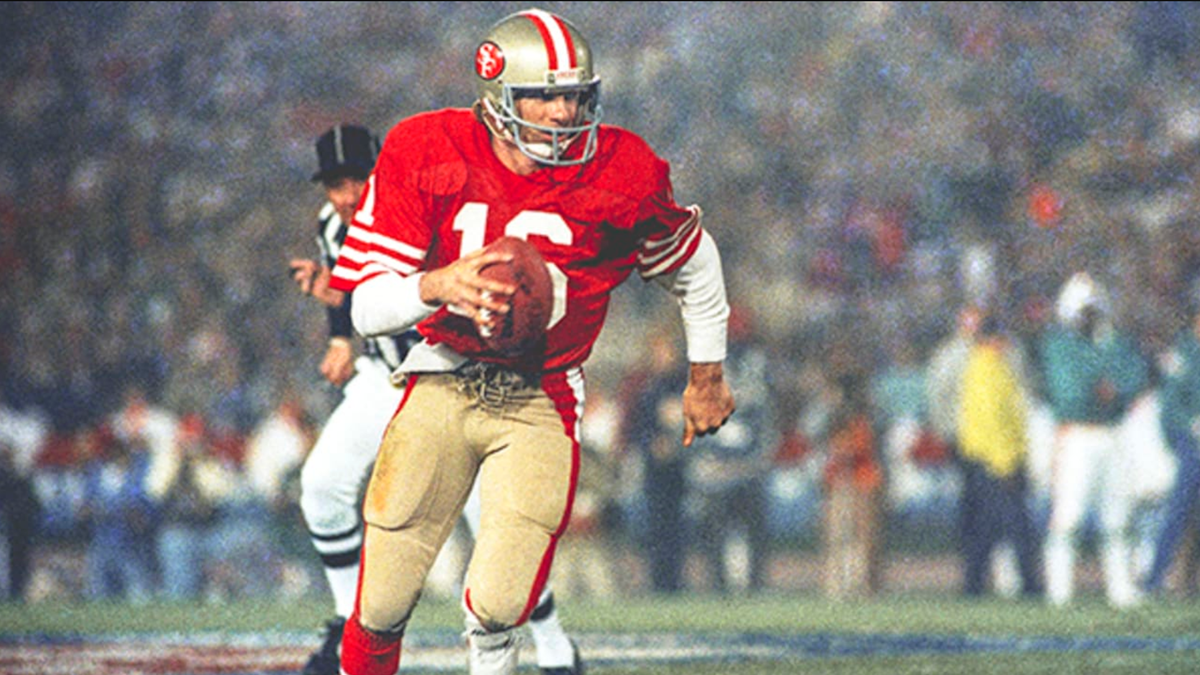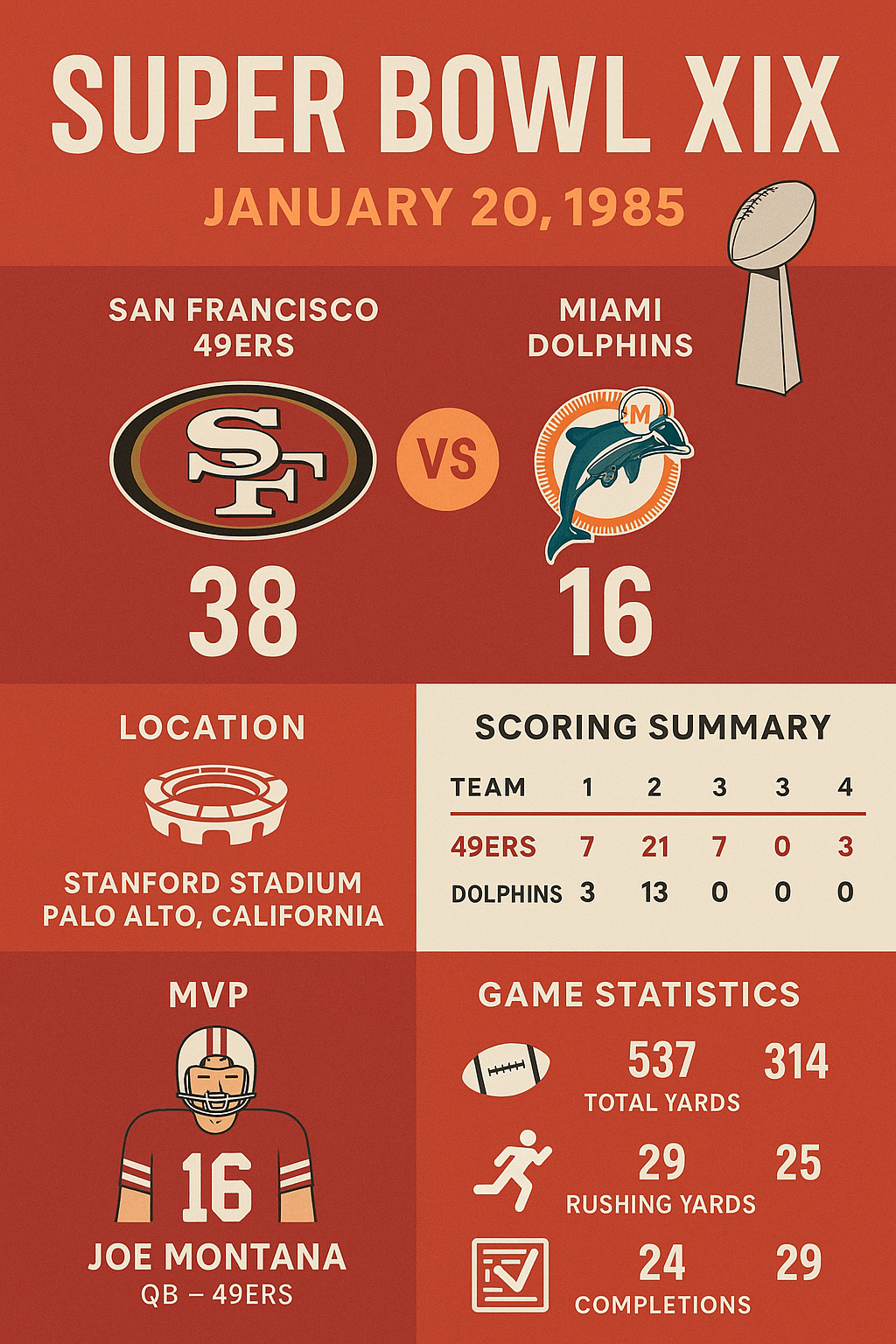Super Bowl XIX: Montana vs. Marino – The Battle for the NFL’s Throne

On January 20, 1985, the NFL world stopped for what many called the “Super Bowl of the Century.” Inside Stanford Stadium in Palo Alto, California, the reigning champion Los Angeles 49ers and the high-octane Miami Dolphins met in Super Bowl XIX, a game billed as a generational showdown between two elite quarterbacks: Joe Montana and Dan Marino.
What unfolded was a masterclass in balance, discipline, and execution. The 49ers didn’t just win—they dismantled Miami’s record-breaking offense, triumphing 38–16 to claim their second Super Bowl title in four years.
Pre-Game Hype: Montana vs. Marino
Super Bowl XIX was historic even before kickoff. It marked the first Super Bowl featuring two 14–2 teams, the first hosted in a college stadium, and the most-watched television event in American history at the time.
But the real headline? Joe Montana, the cool, efficient field general of San Francisco’s West Coast Offense, versus Dan Marino, the second-year phenom who had rewritten the NFL passing record book in 1984 with 5,084 yards and 48 touchdowns.
“It was Ali-Frazier in shoulder pads,” said Howard Trent, senior researcher at the Super Bowl Historical Society. “Marino was the future. Montana was the present. This was more than a game—it was a referendum on quarterback greatness.”
The Dolphins were a pass-first, quick-strike offense under Don Shula, while the 49ers, coached by the innovative Bill Walsh, embodied precision and balance. It was finesse vs. force, innovation vs. explosiveness.
The Setting: Home Field, California Style
Stanford Stadium, nestled in the Bay Area, offered a picturesque setting, though it lacked the modern infrastructure of domed stadiums. Over 84,000 fans packed the venue, and the game drew more than 88 million viewers nationwide—a record at the time.
CBS handled the broadcast, with Pat Summerall and John Madden calling the action. The national anthem was performed by the combined choirs of the San Francisco Bay Area, and the halftime show featured a patriotic tribute titled "World of Children."
First Quarter: Miami Strikes First
The Dolphins came out fast, just as they had all season. Marino orchestrated a smooth drive, moving the ball with short timing routes to Mark Clayton and Mark Duper—the “Marks Brothers.” The drive stalled inside the 10, but kicker Uwe von Schamann nailed a 37-yard field goal to put Miami up 3–0.
San Francisco responded quickly. Joe Montana led an 8-play, 78-yard drive, culminating in a 33-yard touchdown pass to fullback Carl Monroe on a wheel route. It was a sign of what was to come: clever play design and surgical execution.
Second Quarter: The Game Turns
This is where the 49ers took over. After a Miami punt, Montana drove San Francisco downfield, mixing runs and short passes. Roger Craig scored on a 2-yard swing pass to make it 14–3.
Then, disaster struck for the Dolphins. A mistimed snap led to a fumble, setting up another San Francisco score—a 5-yard touchdown run by Craig, extending the lead to 21–3.
Marino kept fighting. Just before halftime, he threw a 2-yard touchdown to Dan Johnson, and Miami cut the deficit to 28–16 heading into the locker room. But by then, the cracks were showing.
“This game wasn’t lost in one play. It was a slow suffocation,” noted Dr. Lisa Marshall, a historian with the Super Bowl Historical Society. “Every time Marino blinked, Montana had already moved the chains. San Francisco didn’t overpower Miami—they outsmarted them.”
Second Half: Total Control
The third quarter was a chess match. Miami’s defense stacked the box, trying to rattle Montana, but he responded with quick throws and smart reads. Craig added a third touchdown—this one a short run—to push the score to 35–16.
Meanwhile, Marino was unraveling. The 49ers’ secondary, led by Ronnie Lott and Eric Wright, disguised coverages and baited him into throws that rarely succeeded. San Francisco’s pass rush—led by Fred Dean and Dwaine Board—pressured Marino into hurried throws and missed opportunities.
Montana kept the offense on the field, eating clock. A late field goal by Ray Wersching made it 38–16, sealing the most balanced, methodical Super Bowl win of the decade.
Final Score
- San Francisco 49ers: 38
- Miami Dolphins: 16

MVP and Star Performers
Joe Montana was named Super Bowl XIX MVP, his second such honor. He finished with:
- 24 completions on 35 attempts
- 331 yards passing
- 3 total touchdowns (2 passing, 1 rushing)
His calm control of the game—both pre-snap and post-snap—was a testament to his elite football IQ and physical ability.
- Roger Craig: 58 rushing yards, 77 receiving yards, 3 total TDs
- Carl Monroe: 104 total yards, 1 TD
- Ronnie Lott: 8 tackles, 2 pass breakups
- Dan Marino: 29-of-50, 318 yards, 1 TD, 2 INTs
- Mark Clayton & Mark Duper: Combined for just 121 yards receiving—well below season averages
Coaching Masterclass
Bill Walsh cemented his status as one of the greatest minds in NFL history. His game plan neutralized Miami’s pass rush by using misdirection, motion, and quick-release concepts. His backfield tandem of Craig and Wendell Tyler provided the versatility to keep Miami guessing.
On defense, coordinator George Seifert crafted a hybrid coverage scheme that took away Marino’s primary reads, using deep zone shells with disguised blitzes and linebacker drops.
Conversely, Don Shula’s Dolphins looked over-reliant on Marino’s arm. They failed to adjust once the deep shots were taken away and didn’t establish the run, finishing with just 25 rushing yards.
Strategic Takeaways
- Balance wins – San Francisco had 537 total yards: 288 passing, 249 rushing. Miami had 25 rushing yards.
- Time of possession matters – 49ers held the ball for 37 minutes, Miami for 23.
- Montana’s mastery – With smart pre-snap reads and perfect ball placement, Montana showed that quarterbacking was about much more than just arm strength.
Cultural and Historical Impact
Super Bowl XIX was a turning point in the NFL’s narrative around quarterback play. While Marino had the stronger arm and gaudier numbers, it was Montana who displayed situational mastery, adaptability, and leadership—traits that became the modern model for championship quarterbacks.
Montana’s second Super Bowl win elevated him into all-time conversations, eventually culminating in four Super Bowl rings. Meanwhile, Marino—despite going on to have a Hall of Fame career—would never return to another Super Bowl.
“Super Bowl XIX crystallized a truth the league has embraced ever since,” said Dr. Marshall. “Stats are nice. But it’s decision-making, balance, and execution that win championships.”
The game also gave Roger Craig national recognition, making him the first player in Super Bowl history to score three touchdowns in a single game—paving the way for future dual-threat running backs.
Broadcast Milestones
Super Bowl XIX was the first to feature a live national closed-captioning feed, and its television ratings set a new record for viewership. CBS’s coverage, particularly with John Madden’s telestrator, helped usher in a new era of advanced football commentary.
Legacy
For the 49ers, Super Bowl XIX was a launchpad into one of the NFL’s greatest dynasties. They would go on to win three more titles over the next decade, all led by Bill Walsh or his coaching tree.
For Miami, it was the beginning of a frustrating pattern. Marino would put up record-breaking stats for the next decade but could never overcome the lack of a consistent run game or championship-caliber defense.
In many ways, Super Bowl XIX was the NFL’s transition into its modern form: explosive but cerebral, fast but efficient.
Final Word
Super Bowl XIX wasn’t just Montana vs. Marino. It was precision vs. power, patience vs. panic, and execution vs. expectation. In a clash that had all the makings of a classic, the 49ers imposed their identity—and never looked back.
Montana proved that calm, rhythm, and mastery still mattered in a league enamored with velocity and spectacle. And with that, the 49ers etched themselves deeper into NFL lore.
“This was a quarterback duel on paper,” said Howard Trent. “But by the fourth quarter, it was a coronation. And Joe Montana was wearing the crown.”
